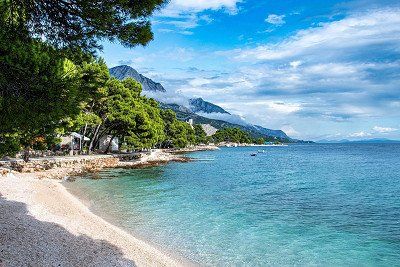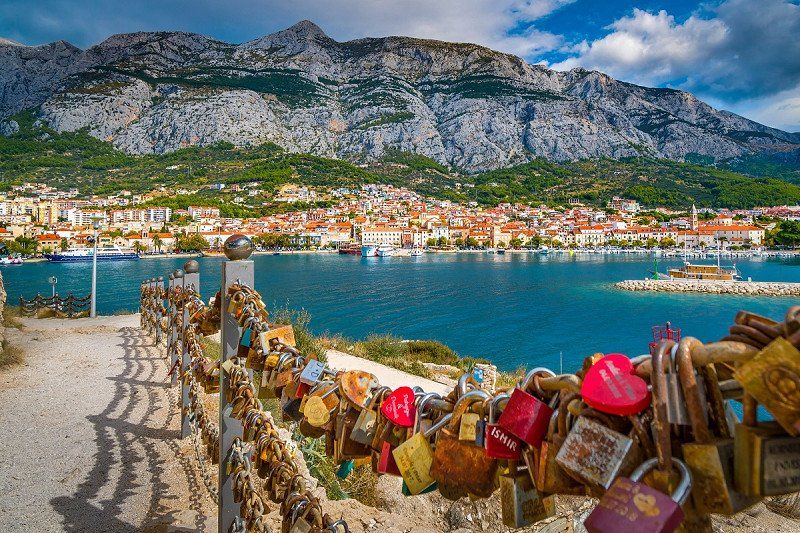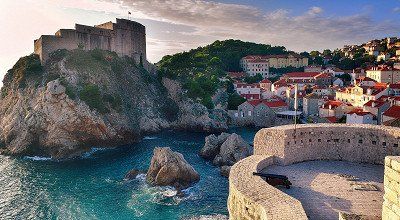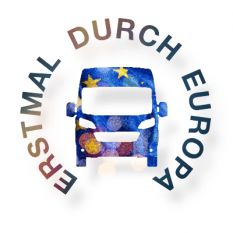Impressive architecture, historical towns, barren karst hills, luscious Macchia, olive groves, little vineyards, golden beaches and turquoise blue water: The coastal region of central Dalmatia in Croatia features a diverse selection of countryside and architectural styles reflecting its time under the Romans, Carolingians, Byzantines, Venetians, and Habsburgs. And those who are not only interested in getting a tan will soon discover that Croatia has so much more to offer than only beaches and the sea. Freeontour presents you with the highlights of the Croatian Makarska Riviera.

Every year more tourists are discovering Croatia
Pure sunshine, miles of pebble beaches, and the unimaginably blue, crystal clear water of the Adriatic coast have been drawing tourists to Croatia, particularly the Dalmatia region, for over a century. However, the breakup of Yugoslavia at the start of the 1990s, and the associated conflicts in the Balkans, meant tourism to the region stopped, and it is only since 1995 that Croatia has begun to recover. But now, the cities, coastal resorts and the Dalmatian islands are shining once again in their original splendour and every year they draw more and more visitors – especially from Germany. Even to the extent that some places have far too many tourists. This has led to the city of Dubrovnik aiming to halve the number of cruise ship tourists as of 2019, so as not to endanger the status of this World Heritage Site.
However, the majority of the tourists to Croatia have one main interest: The seaside, including water activities such as snorkelling, diving, windsurfing and sailing – after all, Croatia and central Dalmatia claim to have the clearest seawater in the world. Whether this is true remains to be seen. It can be said, however, that the water is so clear that even in the harbours you can see the sea floor unaided. Along the Makarska Riviera, stretching around 60 km from Donja Brela in the North to Gradac in the South, there are scores of picturesque fine pebble beaches, which shine like gold in the sun as the turquoise and emerald water washes over them – framed by resinous scented forests of Jerusalem pines.

Makarska Riviera: Fine pebble beaches strung together like pearls
The touristic centre of the Makarska Riviera in Croatia is the small city of Makarska, with its population of almost 15,000 inhabitants and baroque architecture from the 18th century. Peace and quiet are not on the agenda here. Makarska is loud. Even in the off-peak season, there is plenty of hustle and bustle so that anyone wishing to reach the beaches along the seafront or on the peninsula Sv. Petar must first negotiate his way through countless souvenir stalls, bars and tavernas. Numerous boats offering a variety of trips can be found in the harbour, and the street cafés and restaurants are perfectly aligned, unfortunately, with the tastes of the central European palate.
Little villages like Donja Brela are considerably quieter than the touristic centres. Foto: Pixabay
Donja Brela - a more peaceful corner of Croatia
In Donja Brela, just
a few kilometres north of Makarska, it becomes considerably quieter. The
village with its 1,700 inhabitants stretches for several kilometres between
pebble beaches and the rocky massif of the Biokovo Mountains, attracting both
families and the more mature generation in the off-peak season. The locals are
exceptionally proud of their ‘blue flag’, which indicates that the water
quality is excellent, confirmed by fortnightly water tests. The promenade here
is around 6 km long, and quietly winds along the water’s edge, hiding
narrow beaches, and beyond the centre of the village, you will only find a
handful of souvenir stands and snack bars.
Even in the harbour,
it is comparatively quiet. Here you can relax and enjoy a coffee or a Sundowner
in a café or bar overlooking the sea and the island of Brač until the excursion
boats return to harbour in the evening. Then you can recognise the party boats from
afar by their loud music and exuberant passengers as they return after day
trips to Hvar, Brač or other beaches. It takes a good 15 minutes for the dust
to settle again, once all the party boat passengers have found their way back
to their respective accommodation and Brela returns to its relaxed, leisurely
pace. And the boats are already long gone, navigating their way to other
harbours along the Makarska Riviera, for example the neighbouring tourist
hotspot of Baška Voda.

The Biokovo Mountains are ideal for long hikes during spring and autumn. Foto: Pixabay
Hiking in the Biokovo Mountains: A different side to Croatia
If you are looking for something different, then the Makarska Riviera has everything you’re looking for: Spend the morning hiking in the mountains and the afternoon bathing in the Adriatic – no problem. The 60 km long rocky massif of the Biokovo mountain range soars skyward almost immediately behind the golden pebble beaches. Nowhere else on the Adriatic coast will you find the Dinaric Alps so close to the sea. The Sveti Jure, the highest peak in the Biokovo and the Dalmatian region at 1,762 m, is only 5 km from the coast as the crow flies. The Biokovo nature reserve, covering a total area of 196 km², is criss-crossed by over 40 signposted hiking routes. There are different path grades suitable for walkers, hikers, climbers, and mountain bikers, all leading to the top past abandoned shepherds’ stone huts, little chapels, numerous cairns and through a landscape, which grows craggier the higher it goes.
The narrow mountain roads in the Biokovo Mountains are not really ideal for a motorhome excursion. Foto: Pixabay
Croatia’s highest tarmac road - not really a good idea with a motorhome
Even if the Biokovo Mountains seem a bit uninspiring and meagre at first glance, a closer inspection reveals the wealth of hidden plant and animal species – from ladybells and cornflowers, diverse fungi, and gophers, bats, wild boars and chamois. You may even still come across bears and wolves here in Croatia. However, the majority of the Croatian holidaymakers prefer to conquer Sveti Jure on wheels. This means taking the 24 km long mountain road, which starts near to Gornji Tucepi at the entrance to the nature reserve, and brings you in around 1.5 hours to shortly before the summit. But this trip is not for the faint hearted, as the highest tarmac road in Croatia winds its way through the karst landscape with countless curves and hairpin bends. And it is so narrow that when you are faced with oncoming traffic, even if it is only a small car, you are forced to manoeuvre with millimetre precision. This road is not a very good idea with a motorhome, although this hasn’t stopped some drivers from attempting it. So if you do decide to try it, expect angry reactions from the other motorists. But once you are at the top, however you got there: The effort is rewarded with an impressive panorama over the Makarska Riviera, the peninsula Pelješak, and central Dalmatian islands and the hinterland of the Biokovo mountains. It is said that on a clear day, you can even see the mountains of Herzegovina and the Italian Adriatic coast.
The most famous beach in Croatia is on the island of Brač. Foto: Pixabay
Island of Brač: Croatia’s most famous beach and little bays
Moving back to sea level again, we reach the island of Brač by the ferry from Makarska. The highest point on the island is Vidova Gora, at 778 m high. It rises up directly behind the town of Bol, which is at the same time the touristic centre on Brač. Here you will find the majority of the campsites on the island, and a range of hotels, restaurants and bars stretching along the promenade to the famous “Golden Horn”. The beach Zlatni Rat is the most famous beach in Croatia, as it moves from east to west depending on the tide and the wind. In summer, sun worshippers flock to the golden gravel on this 360 m to 420 m long spit, so much so that some locals say you can see more skin than beach in the peak season. This is because it’s not only popular with those holidaying on the island – tourists from the party boats sailing for the Makarska Riviera also make a beeline for this beach.Those who prefer somewhere a little more secluded can find numerous little bays on Brač, best reached by boat. Here you can focus on uninterrupted bathing, snorkelling and soaking up the sun. But in recent years, those in charge of tourism on Brač have come to realise that they can also introduce visitors to the cultural heritage of the island, besides the usual sun, sea and sand. In the little town of Supetar to the north of the island, the emphasis is increasingly on cultural and culinary experiences – from themed hiking and sightseeing tours, to culinary festivals highlighting mangold or spinach, to Gastro-Safaris focussing on wild asparagus. And the incredible island specialities you can enjoy here, such as Bračer sheep’s cheese and char-grilled roast lamb, can’t be found in the tourist hotspots.

If you go exploring the countryside around Supetar, you will discover lots of little bays where you can relax in peace and enjoy the sea. Foto: Pixabay
Island of Brač: Culinary highlights off the beaten track
There are a multitude of delicacies waiting for you in the little mountain villages on the island, for example in the village Gornji Humac. This was previously a shepherd settlement, and the traditional methods of sheep rearing and cheese-making are still followed here today. A good example of this is Konoba Tomić – a family-run company, which has been offering guests home-made products for almost 40 years. Its specialities are lamb meat, a hard sheep’s cheese, ham and wine. These are served in the traditional ambiance of the over 800-year-old stone house, which has been in the Michieli-Tomić family for countless generations. The meat is prepared in the centre of the dining area on an open hearth, and the stone channel running along the floor to the old wine press in the courtyard stems from the time when the wine was elaborately pressed by hand. Those interested in history can while away the time as their food is prepared in the Konoba Tomić by listening to the host recount stories with incredible details and interesting anecdotes. And the home-made Proseć, a schnapps, is excellent for warming the body and cleansing the stomach.
The Diocletian palace in Split with its immense dimensions. Foto: Pixbay
Split: Detour to the Diocletian palace
Taking the ferry from the island of Brač in the direction of Split on the Croatian mainland, will reveal a completely different part of history. Directly next to the harbour area is a huge Diocletian palace, which was built by the Roman Emperor Diocletian in the years 295 to 305 AD. The ruler had the Palace built for his twilight years, with 16 towers, strong external walls, in total covering 30,000 m². A 40-room luxury villa just for him with spas, aqueduct, four temples, stables, accommodation for soldiers and staff. One of the largest private residences ever to be built – not to mention that it is predominantly decorated with the famous island of Brač marble, which has also been used to adorn magnificent international buildings such as the White House in Washington and the Berlin Reichstag. The heyday of this luxury accommodation was only to last 10 years, as it was completely abandoned after Diocletian’s death. Only 300 years later would the palace be brought to life again when it was used as a town.In mediaeval times, new building work commenced – convoluted and interlocking among the old walls so that whole epochs are layered over one another here. Today, the Diocletian Palace, recognised as a UNESCO World Heritage Site since 1979, resembles a large shopping centre with museum characteristics: Designer clothes and jewellery are offered in historical buildings with wrought-iron balconies and coats of arms, shoes are sold under Renaissance gables, and pizza wood stoves stand next to Venetian archways. Naturally, you can also view some of the historical architectural works, such as the Jupiter Temple or the Mausoleum. Peace and seclusion are, however, not to be found within the Palace walls – even early in the morning the place is already bustling with shoppers, tourists and café patrons. Queues are to be expected, but it is definitely worth the wait.

The old town of Trogir is a highlight in every holiday to Croatia. Foto: Pixabay















